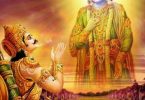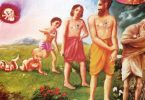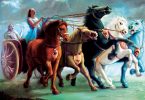Question: If one can go Back to Godhead by following SB 12.13.13, why should one surrender to a sampradaya, take initiation etc.? This question is not being raised with the intention of circumventing the viddhis of sadhana bhakti. Rather, the query is trying to understand what is the actual purport of this verse.
Answer by Romapada Swami:
Seeming exaggerations of benefits derived from devotional practices are explained in NOD and in BRS.
One such statement, from NOD:
In the Bhaviñya Puräëa it is said, “Even if born of a lowly family, a person who follows the Ratha-yäträ car when the Deities pass in front or from behind will surely be elevated to the position of achieving equal opulence with Viñëu.”
BRS ||1.2.168||
Translation: Seeing the festivals, from Bhaviñyottara:
“The dog-eaters and other low persons who joyfully see Keçava on His chariot all become associates of the Lord.”
Jéva Gosvämé’s Commentary
The chariot (ratha) festival represents all other festivals as well. All those (sarve) who see the Lord on the chariot, and even those who are low born or have bad qualities (çvapacädayaù), become associates of the Lord (devatänäà gaëäù).
Summary reply, from the NOD Chapter 13
Çréla Rüpa Gosvämé explains that the results of these items are not over-estimations. They are true in certain cases, and are intended to describe the item’s potential for evoking bhäva-bhakti when executed offenselessly.
– Actual facts
– True for some but may not be for all
– Accepting them as they are stated helps bring detachment from material world and attraction for Krsna.
– Must be performed offenselessly
Sometimes these 64 activities are said to reward one with various worldly benedictions, but Çréla Rüpa Gosvämé explains that this is simply a way of attracting mundane people to devotional service. The actual result of these angas or limbs is bhäva-bhakti.
Actual NOD and BRS texts
“In these statements about devotional service, sometimes it may appear that the results have been overestimated, but actually there is no overestimation. Some devotees, as revealed scriptures give evidence, have had immediate results by such association, although this is not possible for all. For example, the Kumāras immediately became devotees simply by smelling the incense in the temple. Bilvamaṅgala Ṭhākura simply heard about Kṛṣṇa and then immediately gave up his beautiful girlfriend and started out for Mathurā and Vṛndāvana, where he became a perfect Vaiṣṇava. So these statements are not overestimations, nor are they stories. They are actual facts, but are true for certain devotees and do not necessarily apply to all. These descriptions, even if considered overestimations, must be taken as they are, in order to divert our attention from the fleeting material beauty to the eternal beauty of Kṛṣṇa consciousness. And for a person who is already in contact with Kṛṣṇa consciousness, the described results are not unusual.”
(NoD 13: Five Potent Forms of Devotional Service)
BRS 1.2.245
keñäàcit kvacid aìgänäà yat kñudraà çrüyate phalaà |
bahir-mukha-pravåttyaitat kintu mukhyaà phalaà ratiù ||245||
Translation: In some of the verses quoted from the scriptures, material results are attributed to the aìgas for attracting persons possessing material consciousness. However, the main result of these aìgas is rati (bhäva).
Jéva Gosvämé’s Commentary
The main result can be understood from the following verses.
akämaù sarva-kämo vä mokña-käma udära-dhéù
tévreëa bhakti-yogena yajeta puruñaà param
Whether one is without desire [the condition of the devotees], or is desirous of all fruitive results, or is after liberation, one should with all efforts try to worship the Supreme Personality of Godhead with intense devotion (bhäva). SB 2.3.10
satyaà diçaty arthitam arthito nåëäà
naivärthado yat punar arthitä yataù
svayaà vidhatte bhajatäm anicchatäm
icchäpidhänaà nija-päda-pallavam
The Supreme Personality of Godhead fulfills the material desires of a devotee who approaches Him with such motives, but He does not bestow benedictions upon the devotee that will cause him to demand more benedictions again. However, the Lord willingly gives the devotee shelter at His own lotus feet, even though such a person does not aspire for it, and that shelter satisfies all his desires. That is the Supreme Personality’s special mercy. SB 5.19.27
kämaà ca däsye na tu käma-kämyayä
yathottamaçloka-janäçrayä ratiù
Indeed, Mahäräja Ambaréña never desired anything for his own sense gratification. He engaged all his senses in devotional service, in various engagements related to the Lord. This is the way to increase attachment for the Lord and be completely free from all material desires. SB 9.4.20
However, for those persons with material inclinations, material results are mentioned. For the real devotees, rati is the result, because rati is produced simply by hearing about the qualities of the Lord. Even though this worship is easy, it produces results that cannot be attained by other processes. Therefore, bhäva or rati is the main result of practicing the aìgas of bhakti. Though the result of sädhana-bhakti is bhäva, that bhava or rati also has many varieties according to which of the many forms of the aàçé, Kåñëa, the person is worshipping.







